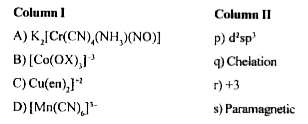Statement-1 : According to crystal field theory, during complex formation, the d-orbitals split and form two. sets of orbitals t2gandeg.
Statement-2 : Splitting ofd-orbitals occurs only in case of strong field ligands.Solution in Malayalam
Statement 1 is True, Statement 2 is True, Statement 2 is Correct explanation for Statement 1.
Statement 1 is True, Statement 2 is True, Statement 2 is NOT a correct explanation for Statement 1.
Statement 1 is True, Statement 2 is False.
Statement 1 is False, Statement 2 is True.
The correct Answer is:C
Splitting of orbital takes place for both weak and strong filed ligands. Pairing of electrons in these orbital s depends on the strength of the filed.
Topper's Solved these Questions
- BOOK - BRILLIANT PUBLICATIONCHAPTER - COORDINATION COMPOUNDS EXERCISE - LEVEL III (Linked Comprehension Type) (Paragraph- I)3videos
COORDINATION COMPOUNDS
- BOOK - BRILLIANT PUBLICATIONCHAPTER - COORDINATION COMPOUNDS EXERCISE - LEVEL III (Linked Comprehension Type)(Paragraph II)4videos
COORDINATION COMPOUNDS
- BOOK - BRILLIANT PUBLICATIONCHAPTER - COORDINATION COMPOUNDS EXERCISE - LEVEL III (Matching Column Type)4videos
COORDINATION COMPOUNDS
- BOOK - BRILLIANT PUBLICATIONCHAPTER - CO-ORDINATION COMPOUNDS AND ORGANOMETALLICSEXERCISE - Level-II (Assertion- Reason)4videos
CO-ORDINATION COMPOUNDS AND ORGANOMETALLICS
- BOOK - BRILLIANT PUBLICATIONCHAPTER - D & F BLOCK ELEMENTSEXERCISE - Level -II38videos
D & F BLOCK ELEMENTS
Similar Questions
Which is correct in the case of [Fe(CN)6]4− complex ?02:35View SolutionWhen degenerate d-orbitals of an isolated atom/ion come under influence of magnetic field of ligands, the degeneracy is lost. The two sets t2g(dxy,dyz,dxz)andeg(dx2,dx2−y2) are either stabilised or destabilised depending upon the nature of magnetic field. It can be expressed diagramatically as:
Value of CFSE depends upon nature of ligand and a spectro-chemical series has been made experimentally, for tetrahedral complexes Δt is about 4/9 times to Δ0 (CFSE for octahedral complexes).

This energy lies in visible region and ie, why electronic transition t2g⇔eg are responsible for colour. Such transitions are not possible d0andd10 configuration.
Cr3+ form four complexes with four different ligands which are [Cr(Cl)6]3−,[Cr(H2O)6]3+,[Cr(NH3)6]3+and[Cr(CN)6]3−. The order of CFSE (Δ0) in these complexes is :
 01:49View Solution
01:49View Solution 02:50View Solution
02:50View SolutionAssertion : The complex ion [Ni(en)3]2+ has lesser stability than [Ni(NH3)6]2+
Reason : ln[Ni(en)3]2+, the geometry is square bipyramidal06:35View SolutionWhich of the following is not the characteristion of transition metal ?
03:27View SolutionIn crystal field splitting for a tetrahedral complex, the number of orbitals pushed down in energy are
View SolutionIn tetrahedral crystal field, three is splitting of d orbitals. Which of the following d orbitals constitute the higher energy set of orbirals.
03:51View SolutionWhich of the following paramagnetic complex with two unpaired electrons in t_(2g) orbital according to crystal field theory
02:00View SolutionAssertion : According to crystal field theory , during complex formation , the d-orbitals split and form two sets of orbitals t2g and eg .
Reason : Splitting of d-orbitals occurs only in case of strong field ligands .02:22View SolutionSketch the splitting of d orbitals in an octahedral crystal field,
View SolutionCrystal field theory considers purely ionic bond between metal and ligand. The five d-orbitals in an isolated gaseous metal are degenerate. The degeneracy of the d-orbitals is lost in prsence of ligand which is known as splitting of d-orbitals. Complex in which t(2g)^(3) electronic configuration is not observed.
01:40View SolutionWhich of the following statements is/are correct? (i) In octahedral complexes, t_(2g) orbitals posses low energy as compared to e_g orbitals (ii) In tetrahedral complexes , t_2 orbitals posses high energy as compared to e orbitals (iii) In octahedral complexes , e_g orbitals possess low energy as compared to t_(2g) orbitals
06:44View SolutionIn octahedral complexes having co-ordination number 6, the degeneracy of the d-orbitals of central atom is removed due to ligand electron metal electron repulsions. In the octahedral complex three orbitals have lower energy, t2g set and two orbitals have higher energy, eg set. This phenomenon is formed as crystal field splitting and the energy seperation is denoted by Δ0. Thus the energy of the two eg orbitals will increase by (3/5)Δ0 and that of the three t2g will decrease by (2/5)Δ0. The erystal field splitling, Δ0 depends upon the field produced by the ligand and charge on the metal ion. Some ligands are able to produce strong field and in these cases, the splitting will be large whereas other produce weak fields and consequently result in small splitting of d-orbitals.
In an octahedral crystal field, t2g orbitals areView SolutionIn octahedral complexes having co-ordination number 6, the degeneracy of the d-orbitals of central atom is removed due to ligand electron metal electron repulsions. In the octahedral complex three orbitals have lower energy, t2g set and two orbitals have higher energy, eg set. This phenomenon is formed as crystal field splitting and the energy seperation is denoted by Δ0. Thus the energy of the two eg orbitals will increase by (3/5)Δ0 and that of the three t2g will decrease by (2/5)Δ0. The erystal field splitling, Δ0 depends upon the field produced by the ligand and charge on the metal ion. Some ligands are able to produce strong field and in these cases, the splitting will be large whereas other produce weak fields and consequently result in small splitting of d-orbitals.
If Δ0<P, the correct electronic configuration of d4 system will beView Solutionअभिकथनः क्रिस्टल क्षेत्र सिद्धांत के अनुसार, संकुल निर्माण के दौरान, d-कक्षक विपाटित होते हैं तथा कक्षक t2g एवं eg के दो समूहों (sets) को बनाते हैं।
तर्कः d-कक्षकों का विपाटन केवल प्रबल क्षेत्र लिगेण्ड के प्रकरण में होता है।06:44View SolutionAssertion : According to crystal field theory , during complex formation , the d-orbitals split and form two sets of orbitals t2g and eg .
Reason : Splitting of d-orbitals occurs only in case of strong field ligands .03:53View Solution

